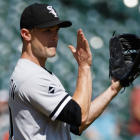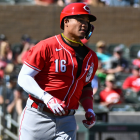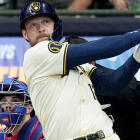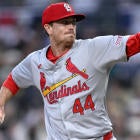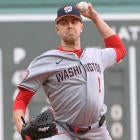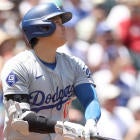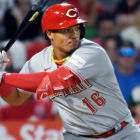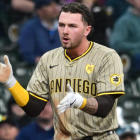Note: Don't whiff on this special FanDuel offer. Win your first contest or get your money back (up to $10) to keep playing Try FanDuel now!
Another day, another closer controversy -- this one belonging to the White Sox.
David Robertson blew his second save in as many days Wednesday, and though he wasn't completely dismantled in either instance, his overall numbers suggest he has outlived his usefulness. He still has a terrific strikeout rate over his 46 appearances but also a 4.18 ERA and 1.42 WHIP.
And it just so happens the White Sox have one of the top setup men in the game.
1. Even more closer turnover?
I'm referring, of course, to Nate Jones, who has put up a line befitting of a closer with a 2.22 ERA, 0.93 WHIP and 9.7 strikeouts per nine innings over 53 appearances.
And he has been even more dominant lately, averaging 13.0 strikeouts per nine innings in 16 innings since the start of July.
He was in line to become the White Sox closer in 2014, but then he had Tommy John surgery and Robertson signed a four-year $46 million deal a few months later. It's that financial commitment that keeps the White Sox from making the switch, in all likelihood, but it also may be what allows Robertson to pass through waivers this month, thus opening the door to a trade.
And as long as a trade is still viable, I imagine the White Sox will continue to feature Robertson in the role, but as soon as that situation resolves itself, which would be no later than the end of the month, all bets are off. If Robertson hasn't righted the ship by then, you may be glad you stashed Jones.
But what about Matt Bush, who recorded a save for the Rangers Wednesday, and Raisel Iglesias, who did the same for the Reds Tuesday? They have pretty good numbers as well -- a 2.56 ERA, 1.06 WHIP and 7.9 strikeouts per nine innings for Bush and 2.09 ERA, 1.16 WHIP and 9.6 strikeouts per nine innings for Iglesias -- and neither Sam Dyson nor Tony Cingrani is exactly locked into the role for those teams. Of course, neither situation is particularly straightforward.
That's especially true for the Rangers. I wouldn't even think Dyson's role is in jeopardy, to be honest. Yeah, he blew a save Sunday, but then he bounced back with one Tuesday. Wednesday was simply a day off for him, as it was for Jeremy Jeffress, who was the Brewers closer before the Rangers acquired him at the trade deadline. I suspect he, not Bush, would be the next in line should the Rangers sour on Dyson.
Iglesias is probably a little closer to becoming the go-to option in the ninth inning. It's what he wants to do, and manager Bryan Price has acknowledged how effective he could be in the role. Yes, Cingrani was unavailable Wednesday, but after he allowed five earned runs in two-thirds of an inning Monday, he might not have gotten the call anyway.
What makes it less than straightforward is the same reason Iglesias is relieving now instead of starting: his shoulder. Is he going to be able to bounce back from each outing quickly enough for the Reds to rely on him in the role? They also have Michael Lorenzen as an option. He's recovering from injury as well, but maybe the two split chances going forward, with Cingrani still factoring. It's about as murky as it gets.
And considering Cingrani wasn't getting regular save opportunities anyway, I'm not sure how much we should care about the Reds closer, whoever it is. Jones might be the preferred stash either way.
2. Happ-iness is the truth
Until very recently, J.A. Happ was only a disappointment to me.
Let me explain. I liked him as a sleeper coming into the year, and in the handful of leagues where I drafted him, he never gave me reason to drop him, obviously. I mean, the guy is 16-3, and that means something in Fantasy Baseball. I generally hold on to players who produce for me.
But I kept waiting for the other shoe to drop. He was succeeding, technically, but it seemed like it was by accident. What made him so effective in 11 starts for the Pirates late last year -- and made me like him as a sleeper in the first place -- was no longer in effect.
Famed Pirates pitching coach Ray Searage had converted him to a fastball-first pitcher, and given the results -- vastly improved command, more than a strikeout per inning -- Happ had absolutely no reason to go back. For those 11 starts, he went from being a pitcher constantly on the verge of losing his job to a borderline ace.
You know why his strikeout rate isn't nearly as good this year? He stopped emphasizing the four-seam fastball, throwing it about as often as before he hooked up with Searage.
What ... the ... heck?
If it impacted his strikeout rate, I assumed it would eventually compromise his overall effectiveness. But that wasn't what happened. Instead, he began to pile up strikeouts again, averaging 11.4 per nine innings to go along with a 1.25 ERA and 0.92 WHIP over his last seven starts.
So much for my theory, right? Well, not exactly. You know what else changed for him during that seven start stretch? That's right: He threw his four-seamer 55.8 percent of the time compared to 37.3 over his first 16 starts.
He's back, baby, and so is my confidence in him. If he can keep this up over the final seven weeks, he might just capture that AL Cy Young yet.
3. Ray of light
I get the feeling Robbie Ray is painfully close to turning the corner here.
I say "turning the corner" because some of his ratios are positively nuts. It takes some special talent to average 11.0 strikeouts per nine innings.
You think I'm exaggerating? Well, here's the complete list of starting pitchers with a better strikeout rate than Ray this season: Jose Fernandez and Max Scherzer.
Yup, special talent.
True, his walk and home run rates aren't great, but neither seems like a permanent affliction. He's actually more of a ground-ball pitcher, which should help curb those home runs, and as for the walks, only once in his last 11 starts has he issued more than two. His rate during that stretch is 2.2 per nine.
Even if those walk and home run rates hold steady for the rest of the season, he's bound to improve. His FIP, which estimates ERA based on strikeouts, walks and home runs, is a respectable 3.66.
And oh yeah, he just turned in his best start of the season Wednesday at the Mets, allowing no runs on three hits and no walks over seven innings. Sure, he had just four strikeouts, but that was after three straight starts with nine or more and nine with seven or more. I wouldn't presume that's going to be a longstanding issue for him.
What I see in Ray is a pitcher making strides with his control and consistency while still demonstrating exceptional bat-missing ability. I wouldn't say I'm rushing to add him in mixed leagues, but I have my finger on the trigger.
4. Gotta catch 'em all
We had some advance warning for Gary Sanchez's arrival, and given the current state of the catcher position, yeah, I went ahead and advised picking him up in two-catcher leagues.
But I wasn't sure he'd play enough to factor in anything shallower. Today, I'm feeling a little more confident.
Since his arrival Aug. 3, Sanchez has started six of the Yankees' seven games, including three behind the plate. During that same stretch, Brian McCann has caught only one game.
Looks like it's pretty cut-and-dried, then: Sanchez is the Yankees' primary catcher, and they value his bat enough to keep it in the lineup even when he's not catching. I mean, they pretty much forced Alex Rodriguez out to ensure it. If I had to guess, I'd say Sanchez is their first choice behind the plate against right-handed pitchers and their first choice at DH against lefties. And with performances like Wednesday's, when he went 4 for 5 with a home run, I see no reason to think that would change.
Granted, it was his first career home run, so we're talking a teeny tiny sample size. But he hasn't struck out at an alarming rate and also has three doubles in his 28 at-bats. He looks like he belongs, and at a position as thin as catcher, that's enough to vault him into the top 12.
I'm keeping him behind the other two rookie standouts at the position, Willson Contreras and Tommy Joseph, but Sanchez may have the most upside of the three.
5. The king has returned
Felix Hernandez owners are breathing a sigh of relief today. Their presumed ace actually looked the part Wednesday against the Tigers, striking out eight over seven three-hit innings, after compiling a 5.26 ERA in his first four starts back from a strained calf.
Granted, that rough patch wasn't the only reason for concern. His average fastball velocity, which has steadily dropped for most of his career, is down another mile per hour this year, and his strikeout rate is at an all-time low. He wasn't bad last year, but he wasn't up to his usual standard either, which in retrospect may have been a first sign of decline.
But I see just as much reason for encouragement. You could argue this start wasn't an isolated event. Three of the four earned runs he allowed in his last start came in the first inning, so over his last 14 innings, he has allowed a total of two earned runs on four hits -- and with a strikeout per inning to boot.
One of the storylines surrounding the return from the DL was the loss of feel for his changeup, which might have just been an attempt to explain away his struggles. But it's his bread-and-butter pitch, and he hadn't used it as much lately. That is, until Wednesday, when he threw it more than any other pitch, according to BrooksBaseball.net.
If that's back, then I'm mostly convinced he's back -- or at least good enough to start again. The numbers he put up last year may be the new normal for him, but a mid-threes ERA from an innings-eater capable of eight strikeouts per nine innings is pretty valuable in this pitching environment.








